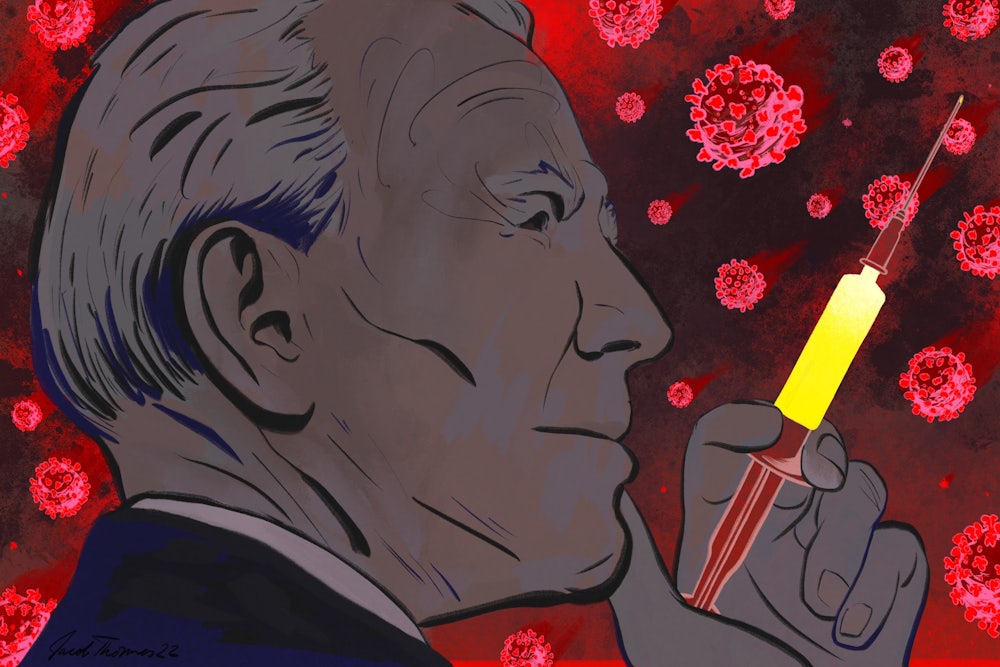When Joe Biden was elected, he promised to treat the pandemic differently from his predecessor. And for a while, it seemed that his approach was working. But a year into his administration, omicron is surging, and many of Biden’s more ambitious plans have fallen by the wayside. On episode 41 of The Politics of Everything, hosts Laura Marsh and Alex Pareene talk with Melody Schreiber, a regular contributor to The New Republic, and the social epidemiologist Justin Feldman. What happened to Biden’s promises? And what has his approach cost us?
Joe Biden [news clip]: That plan will be built on bedrock science. It will be constructed out of compassion, empathy, and concern. I will spare no effort, none, or any commitment, to turn around this pandemic.
Laura Marsh: Joe Biden’s victory speech in November 2020 seemed to mark a turning point in the pandemic. The incoming president had a plan to deal with Covid. He was going to listen to experts and use the tools of public health.
Alex Pareene: Biden delivered on some of that promise. He rolled out vaccines faster than expected in the early months of 2021. But now, just over a year since Biden took office, the outlook is less reassuring.
Laura: When the omicron variant hit in December, the administration wasn’t prepared. They hadn’t made sure there were enough tests for people who needed to work, travel, and see family and friends. The CDC caused confusion with its guidelines on isolation. Hospitals around the country are over capacity, and schools have been forced into battles over closing or staying open. People have largely been left to work out what to do for themselves.
Alex: It’s hard to see what the Biden administration’s plan is, or if there is one anymore. As the epidemiologist Justin Feldman, one of our guests this week, put it, “How did we get in a situation where a Democratic president—who ran, in part, against Trump’s horrid pandemic response—is letting the virus rip?” I’m Alex Pareene.
Laura: And I’m Laura Marsh.
Alex: This is The Politics of Everything.
Laura: We’re talking now with Melody Schreiber, who’s a frequent contributor to The New Republic. Melody, you recently wrote a piece with the title “America Quits the Fight Against Covid.” At the beginning of that piece, you described a moment in May 2020 when the U.S. reached 100,000 Covid deaths and Biden gave a speech. This was before he was president. What did he say, and how did it feel at that moment?
Melody Schreiber: On May 27, 2020, my husband called me into the bedroom and said, “Here’s a video. Watch it.” I said, “OK, it’s a political ad. It’s good to stay updated on these things.” And then Biden said:
Joe Biden [news clip]: There will come a day when the memory of your loved one will bring a smile to your lips before it brings a tear to your eyes.
Melody: He was talking about hitting that milestone of 100,000 Americans dead in just a few months. It felt, to me, as someone who’s been reporting on this pandemic for two years now, like a grown-up in the room finally understood what we were all feeling. It felt like—maybe not right away, but eventually—we could get to a time where we are not only taking real action to prevent death but also acknowledging what we’ve been through. And on a personal level, 12 days earlier, my brother had died. He was 23 years old. He didn’t die of Covid, but it was preventable. And when I heard those words, I felt all the pain that those 100,000 families must be feeling. I thought about how I wasn’t able to say goodbye because we were all quarantining during the pandemic, we were all staying home. I hadn’t talked to my brother in a few months, I hadn’t seen him in a few months. I thought about what a comfort it was to know that someone saw that kind of pain, because often it felt like we were all alone.
Laura: It did feel, at that moment, comforting that someone was at least acknowledging the severity of this and the enormous toll that it’s taken on so many Americans, and that there was some hope—that there was an election coming up later that year, that we could fight this, that we could run someone who was going to have a response to the pandemic. What was Biden’s promise when he was running, and what kind of approach were we led to expect from his administration?
Melody: From the start of the pandemic, Biden was releasing plans for how he would address it. He talked about ramping up testing, surging health care capacity. Everything that the experts were saying was right on. Even just acknowledging that it was happening was a big step. He very much ran on a platform of ending the pandemic. I wrote on the day of the election that this meant America was going to take Covid seriously. I don’t just mean just preventing it or addressing it. I mean really understanding what it meant for us as a country, and maybe even working toward resolving a lot of the grief and trauma of everything that happened in 2020.
Laura: Another thing that’s remarkable to me, just remembering that moment of 100,000 deaths and reading your piece, is that that milestone was marked in a very significant way. At the end of last year, we passed another milestone, of 800,000 deaths. It passed by in a very different way from those first 100,000. Biden’s now the president; the person we thought was going to bring all this hope is in office. How was that 800,000 milestone marked?
Melody: On the day that we hit 800,000 deaths from Covid, the Washington National Cathedral tolled 800 times—one time for every thousand deaths, which is still just not enough. What are we doing now to take action? Where’s the swift action that we need?
Alex: I want to ask that question of you: What is the action? What are the federal government and the White House doing now about the surge?
Melody: The Biden administration is doing some things. They are requiring that insurers reimburse you for eight at-home tests a month, if you can find the tests, and if you can submit the receipts for reimbursement. To some degree, their hands are tied on what they can require. A lot of it is in the hands of governors.
Alex: Right, we can get to that too. There was a Biden sound bite that was taken slightly out of context that went fairly viral, in which he basically said, “This is up to the states.”
Joe Biden [news clip]: Look, there is no federal solution; this gets solved at the state level.
Alex: But to some extent, even if that moment was out of context, that is the federal position here: They have put this in the hands of states. Is that correct?
Melody: Many decisions, like school closures, are going to be up to local and state officials. And to some degree, there’s a void of leadership here. You could say, “This is something that would help, and it’s on the states to do that.” But if you’re not going to tell them what would be helpful, if you’re not going to model it, then it’s less likely to happen.
Alex: I know, for example, in countries like Taiwan, the government began directly manufacturing masks themselves. There was a plan at some point to invoke the Defense Production Act to produce more protective equipment, right?
Melody: In January, the Biden administration released a plan, including invoking the Defense Production Act, in order to expand production of PPE, to expand vaccines, and pretty much anything that you might need during the pandemic. In May, mask manufacturers approached the administration saying, “Now that not everyone is masking, we have all these extra masks. Would you like to replenish the stockpile?” As far as I can tell, that went ignored. Similarly, in the fall, test manufacturers approached the administration and said, “We predict a surge coming around the holidays. Here’s how many tests you will need for every American to stay safe. This way you can send it to them. Do you want to start these contracts now?” The White House seems to have passed on those proposals. And now we have immense testing shortages.
Laura: Do we have a sense of why they passed on all these proposals?
Melody: I think the sense from the administration was, in May, we said vaccinated people don’t need the mask. In July, Joe Biden said we are declaring independence over this virus. You can get together with your friends and family if you’re vaccinated. They very much had a vaccines-only approach, or a primarily vaccine approach, to this pandemic. The second a variant evolved to evade vaccine-induced immunity, we were back to square one, and not prepared.
Alex: Does it seem like they didn’t foresee a variant like omicron that would cause another wave this large, and that they thought it would be therefore safer to just let the vaccine take care of the problem?
Melody: Vice President Kamala Harris has said no one knew a variant was coming, and that’s why we were taken by surprise. If they had talked to any scientist, any immunologist, any microbiologist—everyone was saying, from December 2020, “We know this virus is going to evolve. We know it’s going to evolve to evade immunity, because there’s selective pressure now that some people have immunity from recovery and that people are getting vaccines. The virus that’s going to survive is going to be the kind that can evade immunity.” Everyone knew that. It was pretty clear that was going to happen. It’s clear that it probably will continue happening, even after omicron.
Laura: We know there were things they could have done to prepare, and we know they didn’t. I want to talk with you about what’s been happening over the last month. We didn’t have enough tests for everyone to do the at-home tests before meeting up with family for Christmas, for the new year, for going to work, for going to school. We didn’t have PCR tests that you could get reliably or with any kind of reliable turnaround time. I actually had a PCR test that came back five days late, and my husband’s never came back because they were doing the whole thing on a paper form, and his handwriting is terrible. We think that they just couldn’t contact him because they had no idea who this person was. I want you to take us through the real-world consequences of that for people who are trying to not just be at home all the time, who need to have tests, who need to see family, who need to go to work. What have the effects been for the last month?
Melody: Without tests, without knowing if we have the virus or if we are infectious, we’re flying blind. You can hope that maybe you haven’t come into contact with someone who has the virus, and maybe you don’t have it. Where I am, that’s very unlikely. One in 50 residents of my county tested positive in the past week.
Laura: You’re in Maryland?
Melody: In Maryland, yes, outside of D.C. That’s only for PCRs. At-home tests, as far as I can tell, aren’t reported in Maryland. And that is if you can find a PCR test. The rates of community transmission are massive, and we don’t know if we have it. I also wrote recently about relying on hospitalization data. We’ve been using that to tell how severe a virus, variant, or a wave is. Cases might go up, but what if hospitalizations stay flat? That that would be good, right? The problem is that hospitalizations are more or less going to stay flat because we’re at capacity. We can’t admit more people in many of the hospitals we have. If we’re looking at hospitalization data to see a sharp increase, we might not see it, because they can’t increase anymore.
Laura: That is one of the most frightening things I’ve heard, at a time of hearing a lot of frightening things. I was actually just about to ask you more about hospitals, because one of the things I have found so hard to navigate in trying to understand what’s been going on over the last six weeks or so is that we keep hearing that it’s mild. I think anecdotally, a lot of people understand that—because they have tons of friends and everyone’s getting Covid and recovering on the whole, or a large number of people are. At the same time, you look at the number of people who are in hospitals and see the hospitals over capacity. Clearly, there is a very large number of people for whom this is not mild. That may be a small percentage of total cases, but it’s still a really large number. What is the pandemic like for those people? And also, what are the effects of hospitals being overfilled in general, not just for if you get Covid, but if you need to go to the hospital?
Melody: If a variant is more mild but more transmissible, it more than cancels out those gains. If you have a high percentage of a low number, that’s bad. If you have a low percentage of a very high number, that’s worse.
Alex: That’s worse in terms of the overall number of people.
Melody: The other thing I want to point out about omicron being milder: Omicron, it seems, is milder when it comes to infecting lung tissue, but it can still infect your throat, your nose, and your other vital organs. It’s only seeming to have trouble replicating in the lungs. But what doctors are seeing more and more is diabetic ketoacidosis, which is when you have complications from diabetes. They’re seeing cardiac complications. They’re seeing all of these complications that were present before, when patients were on ventilators, that doctors had to treat, but now they’re just not on ventilators. That’s the main difference with omicron. The problem is you still need to go to the ICU if you’re having complications like that. So that’s kind of the tricky thing with saying omicron is milder.
In terms of what it means for hospitalization, our nurses, health care workers, janitors, cafeteria workers, and ambulance drivers are at a breaking point. This is going to have huge repercussions for our health in five or 10 years. More immediately, I’ve been getting calls for the past day or so from my family, who live in a state where crisis standards of care were just implemented, and they are saying, “At what point do I need to go to the hospital? I’m pretty sick. Will I even be seen?”
Laura: One of the things I found more dismaying from Rochelle Walensky, the director of the CDC, was this comment she made recently where she explained that, of the vaccinated people who were hospitalized, it was encouraging that they were people who were already very unwell and who had multiple comorbidities.
Rochelle Walensky [news clip]: The overwhelming number of deaths, over 75 percent, occurred in people who had at least four comorbidities, so really these are people who were unwell to begin with, and yes, really encouraging news in the context of omicron—this means not only just to get your primary series but to get your booster series, and, yes, we’re really encouraged by these results.
Laura: A lot of people reacted to this, I think quite understandably, as if she was saying, “If you have a chronic illness, or you’re vulnerable, it’s just sort of inevitable that you’ll get really sick and be in the hospital and that we can’t do anything to protect you from that.” It seems like the Biden administration has sort of written those people off. It’s a really sizable portion of people.
Melody: I do think in the context, that clip was misspeaking; it’s not encouraging to see people with comorbidities die. That’s a pretty low bar. I think even saying that they had comorbidities and so it was inevitable is not true. If you stop the spread of Covid, then people with comorbidities are not going to die of Covid. Most Americans have some kind of comorbidity. But second of all, if people have a chronic illness, their lives are no less valuable. I think you can tell a country’s response by how well they protect the vulnerable, and that’s across the board, that’s not just during a health crisis. That’s at all times.
Alex: Very well said. Thank you, Melody.
Laura: Thank you so much.
Alex: You can read Melody Schreiber’s reporting on the pandemic at The New Republic.
Laura: After a short break, we’ll be back to talk to Justin Feldman, a social epidemiologist at Harvard, about why Biden changed his approach to the pandemic.
Alex: We’re speaking now with Justin Feldman, a social epidemiologist at Harvard. Justin recently wrote an article on Medium called, “A year in, how has Biden done on pandemic response?” Justin, thank you so much for joining us.
Justin Feldman: Thanks for having me.
Alex: We were just talking to Melody Schreiber, in part comparing what President Joe Biden said he would do if elected president back in 2020 versus what his administration has done. I want to ask you, do you see a disparity between what Biden said his administration would do and what they are currently doing while in power?
Justin: Definitely. I think the clearest illustration of this is to look at the pandemic response plan that the Biden transition team developed and that they released on January 20, Inauguration Day. There were provisions—or plans, rather—to hire a Public Health Service Reserve Corps of 100,000 federal workers who would help with things like vaccination and testing, to massively increase testing capacity. There were a whole variety of proposals. There was never really an attempt to do most of these things.
Alex: And why do you think that is? I remember these plans, but what do you think happened?
Justin: What I think happened is two things: One, they got the first results for vaccine efficacy. The Pfizer results delivered back in, I think, November 2020 showed 95 percent efficacy against symptomatic disease, which was much higher than expected. The other thing that happened was simply that the political reality, or rather the political considerations, of corporate interests and profit conflicted with some of the most effective public health measures. So they were really planning on widespread vaccination bringing the pandemic down to very low levels of infection, where we could just go on about our lives as normal. That is certainly not what happened.
Alex: I want to get into the efficacy, politically and health-wise, of the vaccine-only approach. But first I want to continue talking about this disparity. The Biden administration and the Democratic Party’s promise was essentially, “Elect us, we will follow science and subject-matter experts, and scientists will be in charge of decision-making.” “We will listen to the experts” is one of the primary Democratic Party sales pitches. Have they followed through on that? Are health experts in charge of Biden administration policy?
Justin: No. Very easy one! Actually, Anthony Fauci was recently answering questions in the U.S. Senate, and a Republican senator asked, “Who is in charge of the federal Covid response?” The answer Fauci gave, which is the correct answer, is Jeffrey Zients. Zients is the White House Coronavirus Response Coordinator, the number one person driving Covid-response policy. He has a background in private equity and management consulting, and under the Obama administration, he was known as the ambassador to the business community for the Obama administration.
Laura: Let’s talk about why a vaccine-only approach, or a largely vaccine-only approach, was so appealing to them. What is the benefit politically of saying, “We give you two shots and then we’re done?”
Justin: This has been going on a really long time in public health. If you can solve something within the health care system, you don’t have to solve it in society at large, because addressing public health in society at large means regulating businesses, which means it’s going to be more expensive to those who are in power economically.
Laura: So when the Biden administration goes for this vaccine-only approach, they push out the vaccines, and it seems to be going well for the first few months of 2021. What’s the turning point?
Justin: There was this rollout of vaccines, and then there was a moment that came when every adult in the U.S. was eligible, in April 2021. Basically two weeks later, what they decided to do in the White House was scrap everything else. That was the infamous May 13 change to mask guidance, where they said, “If you’re vaccinated, you no longer have to wear a mask in a public setting.” You also had this really hard turn to the language of personal responsibility. So CDC director Walensky said, “Your health is in your hands,” at that point, rather than something like, “We’re all in this together.”
Laura: She was emphasizing that your health is in your hands: If you get the vaccine, you will be protected, and then you won’t need to wear a mask. You can go to a restaurant. You can go inside. You can go grocery shopping without wearing a mask. You can have a normal life back. In the early summer, at least as I remember it, the vaccines becoming widely available coincided with a period of very low rates of Covid. It seemed like everything was heading in the right direction. Then cases start going back up again. At that point, you might expect the administration to adapt and to start bringing in some more measures. There were some things slowly, but as you write in your piece, the Biden message has remained:
Joe Biden [news clip]: This continues to be a pandemic of the unvaccinated.
Laura: Explain what he means by that, and what does that phrase conceal?
Justin: In the U.S., the CDC and White House have been saying this is a pandemic of the unvaccinated since, I think, July. They wanted to cast the pandemic in very individualistic terms. You can make the choice and opt out of the pandemic, or you can remain unvaccinated and have your health at risk. Let me be very clear here that vaccines reduce individual risk considerably. Unless you’re immunocompromised, you get a lot of protection from the vaccines. At the same time, the power of the vaccines has somewhat weakened due to waning immunity, and these variants are much more transmissible than the variants of the past. So while Fauci was claiming that 99 percent of people dying were unvaccinated, CDC’s actual data showed it was something around 18 percent of deaths were vaccinated people. I wouldn’t be surprised if there’s a bit of a lag in the data and about a third of the people dying are vaccinated.
Laura: When I came across some of those figures—you quote some of them in your article—I was very surprised, because you don’t see those numbers being cited at all in news coverage. I think that there are two different types of statistics being used here. One is that the CDC and the government talk a lot about the percentage of vaccinated people getting severe Covid among all vaccinated people. But what you’re talking about is: If we look at the number of people who are dying, what percentage of them are vaccinated? That’s actually quite a high percentage.
Justin: So CDC had a webpage, and it listed the number of breakthrough cases, breakthrough hospitalizations, and breakthrough deaths. It removed that webpage. I think a lot of the conversation around that, a lot of the justification, has to do with not wanting to fuel anti-vax sentiments. But that’s kind of a convenient explanation. It also conceals the fact that their policies are failing to do what they’re claiming their policies do, which is protect vaccinated people.
Laura: I actually didn’t even know that they had ever had a webpage with that information, because I’ve heard so many vaccinated people say, “I just wish I knew, when I see these numbers of people who were hospitalized and died, I wish I knew how many of them were vaccinated.” That would be some indication of if there is a real risk for vaccinated people. It seems like if you want to get that information right now, you have to go to the states and download CSV files of raw data.
Justin: I’m an epidemiologist. I use messy data sets from government agencies all the time. I had to really dig around the CDC website, find the spreadsheet, the CSC files, and do the math myself because they do not make it easy to find.
Laura: I want to go back to the big narratives the administration has been pushing. We had the pandemic of the unvaccinated, and then especially with this large last surge and a lot of vaccinated people having breakthrough Covid, that phrase has been harder and harder for people to accept or to understand in a straightforward way. In your piece, you talk about the next talking point from the Biden administration being this phrase: We have the tools.
Joe Biden [news clip]: We have the tools to protect people from severe illness due to omicron, if people choose to use the tools.
Laura: What does that mean?
Justin: Instead of implementing new public health policies or even pushing states and local governments to implement public health policies, the approach has been a change in framing. “We have the tools” is often coupled with “This isn’t 2020 anymore.”
Laura: Factually true—factually, it isn’t 2022 anymore!
Justin: The main tools that CDC, the White House, and media as well are speaking of are boosters, masks, and tests, especially rapid, take-home tests. There’s this idea that because these products exist, you can calibrate your behaviors based on your personal risk tolerance and choose which products to use when, and we’re not necessarily going to give you clear guidance. We’re not going to require them of you, and we’re not going to provide them to you.
Laura: An infuriating thing about hearing “we have the tools” is that the tools exist, OK, they’ve been invented. But we can’t get them. I tried to get tests over the holidays, and I luckily already had a supply of masks that I trust, N-95 masks. Those are out of stock where I was getting them now. So it feels like something that is technically true but on a practical level untrue.
Justin: I almost think it’s intentional. They want us to keep shopping, keep going to work, and not worry too much. We’ve had pretty explicit communication by multiple White House officials and the CDC that if you’re vaccinated and you get infected, you’re probably going to have a mild experience and you don’t have to worry about it. I think the reluctance to push for better masks or more aggressive testing is directly tied into that and also directly tied into this yearlong approach where they did not make the preparations where we could have the tools. There are shortages.
Laura: It seems like we needed to have stockpiles of the masks and the tests, at the bare minimum, to distribute at the beginning of December. Do you see any change on the horizon toward having that in place for the future? Or do you think this is the approach: just to keep going, to let people get Covid and say, “They’ll probably be OK, and they can go back to work”?
Justin: I don’t think the approach is going to change considerably unless we see something like a much more deadly variant. What we are seeing is, because of growing criticism, there are some pivots, relatively small ones. We see things like changing health insurance reimbursements so you can get some antigen tests reimbursed. There’s going to be a website set up where you can start to order a few tests for free online. But I also want to note that I’ve been in public health for over a decade, and we know that you can’t just provide individuals with tools and expect that they’re going to use them and that’s going to be a successful public health strategy.
Alex: It reminds me of the common messaging around all sorts of health interventions, in which politicians will say things like, “Ask your doctor about blank,” or “Go to your doctor about blank.” I just don’t think there’s an awareness among the political class that many people don’t have “their doctor,” and it’s often difficult and perhaps expensive to see a doctor.
Justin: The biggest predictor of whether or not someone’s vaccinated is not the political party they belong to. There is a big partisan divide, but the bigger divide is who is insured and who is uninsured.
Alex: That’s fascinating. That’s because even though the vaccine—remarkably—is free, when I got vaccinated, they took my insurance. It seems really obvious that that simple fact discouraged a lot of people from seeking it out.
Justin: Definitely—if you’re undocumented, for example, and fear having contact with someone who looks like an authority figure. We find, to date, the people who remain unvaccinated tend to be low-income, uninsured, like I said, and also there’s more people in their late seventies and in their eighties who are unvaccinated than you’d expect.
Alex: To what extent are these government failures—you could call them a result of an ideological attachment to our capitalist system—but to what extent are they a result of wanting to perpetuate the system, and to what extent are they—this is my pet theory—to what extent are they the result of a tacit acknowledgment of the limits of our system? On the one hand, “We have to do things because this is our system,” and then, on the other hand, “We can’t do the things that would actually help because we’re stuck with this system.”
Justin: My brief thoughts on that: One, a good, or rather a better, pandemic response than what we have is possible even under capitalism. We can look at Canada, which has had fewer than half the deaths per capita compared to the U.S. I think some of the main political or economic barriers were around what you would have to do—and what we did do—to try to protect people. We created a temporary massive welfare state, and what happened was that it increased the cost of labor while it decreased the supply of labor, and the business class didn’t like that. There was this concerted push to get rid of those things.
Laura: Something that came up when we were talking about this episode was that the current framing in the media is as if there are two camps of people talking about Covid. One is a kind of Covid fatalism: “Everyone’s going to get it, so just get it. We have to live our lives, no more masks, we’ve had the vaccines, it’s the most we can do.” Then the other camp is characterized as a kind of Covid-zero, the people who want everyone to be in lockdown and for schools to go remote for the next year. It seems to me that this is a complete mischaracterization, but that it’s very hard to define what the reasonable response would be somewhere between those two. How do you tackle that characterization?
Justin: I think the people who are painting it as a binary are using Covid as a foil, as a way to say that really any public health measures beyond vaccination are unrealistic. Especially now, but even throughout the pandemic, Covid-zero has barely been visible as a political force or as something people within public health in the U.S. have even advocated. I think what many of us have advocated is doing better than we are doing. For the present moment, for omicron, it’s very easy to make the argument that we could do a lot better. We don’t have to prevent all infections. We can have simple goals, like not overwhelming the hospitals, delaying people’s infections so we can scale up the production of the one monoclonal antibody that works and of Pfizer’s new, powerful antiviral drug. If we were to spread the infections that are going to take place over the coming weeks instead into coming months, one, we’d have fewer infections overall, and two, we’d be better able to care for everyone.
Laura: Thank you so much for coming on. It’s really been great talking with you. The piece was amazing, so thank you for writing it.
Alex: You can read Justin Feldman’s article, “A year in, how has Biden done on pandemic response?” on Medium.
Alex: The Politics of Everything is co-produced by Talkhouse.
Laura: Emily Cooke is our executive producer.
Alex: Melissa Kaplan is our audio editor.
Laura: If you enjoyed The Politics of Everything and you want to support the show, one thing you can do is go wherever you listen to the podcast and rate the show. Every rating and review helps.
Alex: Thanks for listening.






